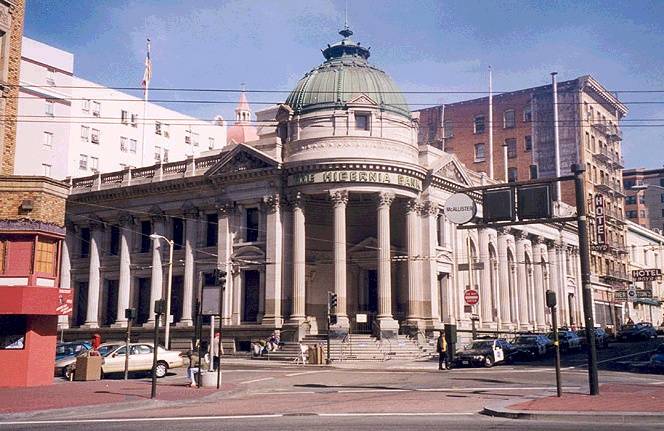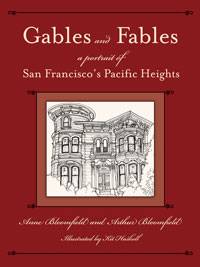Beaux Arts in San Francisco
Historical Essay
by Anne Bloomfield and Arthur Bloomfield
The light-filled rotunda fronting and acting as focal point of this Classical Revival mansion at 2698 Pacific doesn't actually imitate the Temple of Vesta in the Roman Forum; it sources seem at once older (in the exotic columns) and newer (in the coffered Renaissance ceiling).
Illustration: Kit Haskell
Surely Roman are the house's rounded colonnade and low-pitched conical roof. The round Roman temple form has a certain history in San Francisco. The noted architect Albert Pissis is responsible for two examples, the long-lost 1884 building that showed off the city’s “Panorama,” and the entrance to the Hibernia Bank Building at Market, Jones and McAllister—a building Arthur says he couldn’t help noticing when, as a ten-year-old, he frequently took in Saturday afternoon movies at the cinema palazzos nearby.
The Hibernia Bank building at the corner of Jones, McAllister, and Market built in 1892.
Photo: Chris Carlsson
As can be seen in the case of 2475 Pine, all good buildings, it seems, have the potential to become parking lots.
This is what happened to St. Rose Academy on the south side of Pine Street just east of Pierce, a lovely pile designed by Albert Pissis who, as a colleague of his put it in the local architects’ magazine in 1909, is “responsible for more graceful, dignified and well-planned structures on the streets of San Francisco than any single practition-er in the Bay City.”
This article went on to toast a mere forty-four Pissis buildings, including the Emporium, the Flood Building across from it on Market Street, the old White House department store (now housing Banana Republic) at Grant and Sutter, the Mechanics’ Institute on Post, and of course the Hibernia Bank, San Francisco’s first Beaux Arts Classical building.
Mentioned too, naturally, was St. Rose Academy, a building which always reminded Arthur of an opera house on some great street like Berlin’s Unter den Linden. Dedicated in March 1906, it weathered the great earthquake of the following month with only $10,000 in damage to plaster and such—and how much did it cost to demolish it eighty-five years later?
Born in Mexico in 1852 and a San Franciscan from the age of four, Albert Pissis—-remember to pronounce it PEE-sees!—-was trained at the Ecole des Beaux-Arts in Paris and was San Francisco’s earliest confirmed product of that prestigious institution, which influenced so much American architecture of the early twentieth century, including the “Bay City’s” Civic Center.
Reprinted from Gables and Fables: A Portrait of San Francisco’s Pacific Heights by Anne Bloomfield and Arthur Bloomfield. Illustrations by Kit Haskell. [1].
© 2007. Heyday Books, Berkeley, California.



